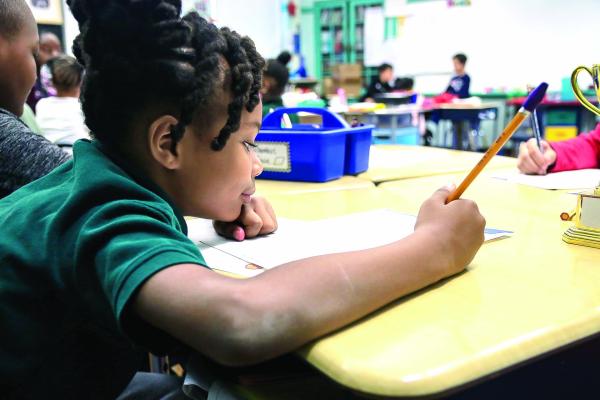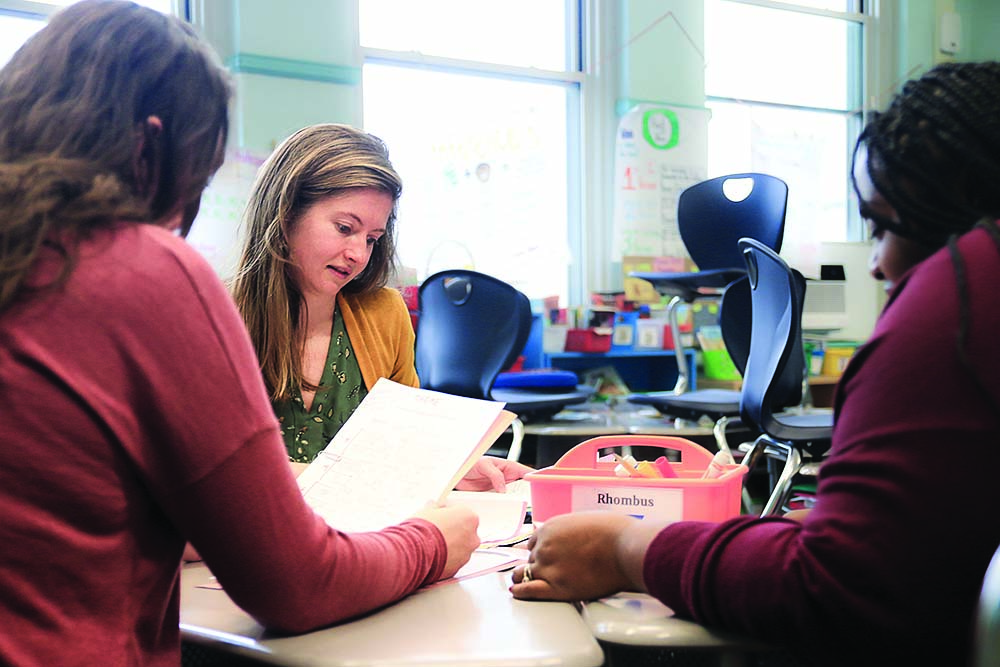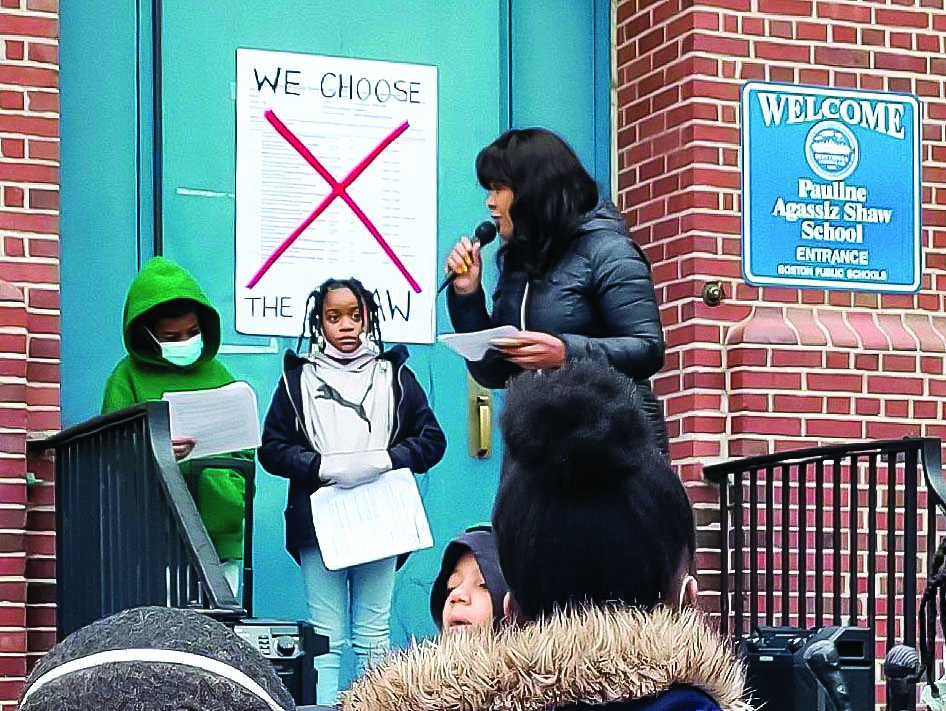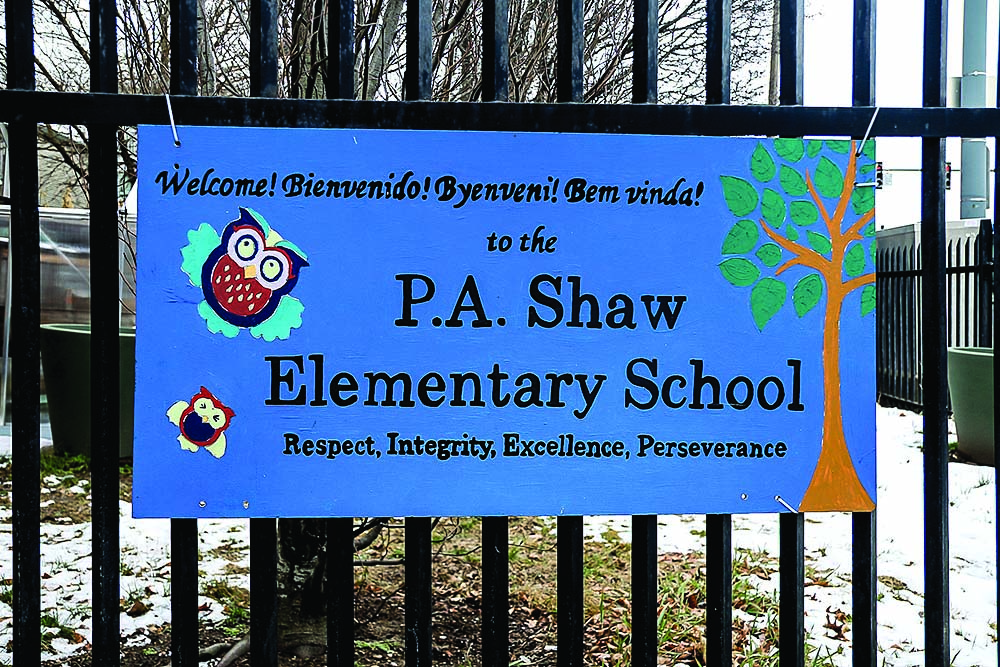February 9, 2023

Emersyn, a second-grade student at the P.A. Shaw School, worked at her desk. Her mother, Brenda Ramsey, is among a group of parents and teachers who oppose a BPS plan to merge the Shaw and the nearby Taylor school. Emily Piper-Vallillo photos

Emersyn sits with her classmates in a circle on the rug. The second graders greet one another—“Hi Emersyn”—and count the days of school with the help of dots on the wall.
What Emersyn loves most about her school, the P.A. Shaw on Norfolk Street, is that the people in the building know and care about her.
“My teachers love me,” she says, “even if I’m having a hard time.”
So, when Emersyn learned that Boston Public Schools planned to merge her elementary school with another school twice its size, the idea worried her. She did not want her community to fracture.
“I don’t want to lose my friends.”
The merger of the Shaw school is part of the district’s effort to combine small schools that face declining enrollment. With 187 students averaging 30 per grade according to district data, the Shaw is a small school. And it’s not the only one.
The district has six smaller elementary schools that are not being merged. They all have fewer Black students, fewer Latinx students, and more white students than the Shaw.
Emersyn’s mom, Brenda Ramsey, says she would like to think the district isn’t treating her daughter’s school differently because of the race of the students. “But if I don’t think that,” says Ramsey, “I’m just being naive.”
An issue of equity
Last May, Mayor Michelle Wu announced a Green New Deal for Boston Public Schools, a $2 billion investment to upgrade facilities for 21st-century learning and sustainability.
Investment in school buildings is long overdue. Two thirds of Boston’s schools were built before World War II, according to the district’s online data dashboard. But the first concrete plans in the Green New Deal don’t involve construction. They involve merging small schools, like Emersyn’s, with larger ones.
The Green New Deal plan discusses a long-promised new PreK-6th grade school that would house students on the west side of Dorchester and Mattapan. However, according to the Green New Deal website, building that school will require looking at merging several small neighborhood schools.
That new school had been promised in 2021, but a site could not be located. Under the Green New Deal, the city would commit funding, site selection would be accelerated, and the design work would be launched. Talks with the various schools about mergers, and potential closings, were to start this year, but there is no indication that has happened at all of the schools - which included not only the Shaw and Taylor, but also the Sarah Greenwood, the Joseph Lee Academy, the Kenny School and the Oliver Wendell Holmes School. Others also mentioned to the Reporter by sources have included the Russell Elementary School and the Roger Clap Elementary, both in Dorchester.
The district officially proposed three school mergers last May, one of which they postponed indefinitely. Those remaining would combine the Sumner with the Philbrick in Roslindale and the Shaw in Dorchester with the Taylor in Mattapan.
Roughly 1,000 students would be impacted by the two mergers, 40 percent of whom are Black. Of the 545 students who would be impacted by the Shaw-Taylor merger, 70 percent are Black (28 percent of the overall district’s students are Black).
The proposal will come before the school committee for a vote in May, according to BPS Superintendent Mary Skipper. If approved, the Shaw-Taylor merger would be complete by the fall of 2024. Many are still uncertain of what is happening with the discussions around the other small Dorchester elementary schools.
The district says mergers are an issue of equity.
“This proposal would support our district-wide shift to ensure all of our students have predictable pre K-6 pathways in safe, healthy buildings that meet our quality guarantee,” Skipper wrote in an email to families.
Ramsey agrees—this is a matter of equity, and Emersyn deserves a great school. But in her eyes, Emersyn has a great school. It’s just in an outdated building. It’s the process of merging these schools and its disproportionate impact on Black students like her daughter that is the equity issue.
Sorry shape
What Ramsey remembers from her first visit to the Shaw are small moments: teachers encouraging her daughter to take books off shelves, the principal greeting her with a smile, her daughter whispering, “Mommy, she looks like me.”
It’s hard for her to believe that dismantling this community—where Emersyn feels seen and respected—is about what’s best for her daughter, especially because the plan seems counterintuitive.
If approved, the Shaw and the Taylor would become a single Pre-K to 6 school. That new school would be split across two campuses—a lower and an upper—and housed in the same buildings that the Shaw and Taylor currently occupy.

Shaw teachers huddle up in a fourth-grade classroom. From left: Morgan Keohane, Tracy Curtin, and Sabine Ferdinand. Emily Piper-Vallillo photos
Shaw second-grade teacher Sabine Ferdinand does not understand how the merger would lead to the improved facilities promised by the Green New Deal.
“I could understand if there was a new building being constructed,” Ferdinand said in an interview. “But right now they are saying you’re going to have a bad building, and you’re going to have a bad building, but we’re going to put you together. What’s the benefit?”
Shaw fourth-grade teacher Tracy Curtin agrees. “Both of our buildings are in pretty sorry shape,” she said, noting that neither the Shaw nor the Taylor has a gymnasium, a cafeteria, a library, or an auditorium. The Shaw has a classroom that functions as a library, but not an actual library. Shaw librarian Morgan Keohane bought the books with grant money, without funding from the district.
In contrast, the other proposed merger would allow the Philbrick and the Sumner to move into the newly renovated Irving building, according to Mayor Wu’s office. Wu has not shared plans for new or upgraded facilities for the Shaw and the Taylor, which combined have three times as many Black students as the Philbrick and the Sumner.
To Edith Bazile, the executive director of the Black Advocates for Educational Excellence and a former Shaw educator, the lack of resources allocated to the Shaw-Taylor is typical.
“Certain communities are not valued equitably,” says Bazile. “Some communities hoard resources, and others get nothing. How can you say this is not about race?”

Edith Bazile, the executive director of the Black Advocates for Educational Excellence and a former Shaw educator, spoke at a recent rally alongside Shaw students. “Some communities hoard resources, and others get nothing,” she says. “How can you say this is not about race?”
Neither the district nor the office of the mayor responded to requests for comment.
In one meeting, Curtin remembers district officials encouraging Shaw and Taylor teachers to creatively reimagine how to use the two buildings.
“But there was no talk about any resources that were going to be given,” she said. “I was sitting at the meeting thinking, ‘Would you ever bring this to the suburbs?’”
Families leave
Over the last decade, district enrollment has declined by about 18 percent—even as the number of school-aged children in Boston has remained static.
When schools are funded to some degree on a per-pupil basis, as they are in Boston, fewer students means less money for teacher salaries and academic resources.
The district says merging schools would allow them to better use limited funds. Instead of hiring two math teachers for two different schools, for example, they could hire one math teacher and use the money saved for something else.
Ruby Reyes, executive director of the Boston Education Justice Alliance, views enrollment differently. When people talk about decline, she says, they often act as if the only solution is closing schools. But it would be better to investigate why students are leaving the district in the first place and try to get them to stay.
It’s hard to say precisely why students are leaving—the district does not conduct exit interviews. But according to district data, the majority of those leaving are Black. Emersyn’s older sister, Nisariah, was one of them. Like her sister, Nisariah attended the P.A. Shaw.
For many parents, enrolling their children in a school can feel like a leap of faith. For Ramsey, the leap was even greater—the district had a habit of closing schools in Dorchester.
“Boston Public Schools has closed so many schools in this area without conversations,” Shaw K1 teacher Carla Johnson said. “The Shaw was one of them.“
In 2008, the school committee voted to close the school—along with five others—under then-superintendent Carol Johnson’s plan to consolidate the district.
“The school was a thriving community,” Johnson recalled, “and it was closed.”
In the following years, the community pushed for a neighborhood elementary school and in 2014, the district allowed the Shaw to re-open with a pre-kindergarten and kindergarten classroom.
That’s when Emersyn and Nisariah enrolled.

A sign on the fence outside the P.A. Shaw School at the corner of Morton and Norfolk streets. Photos by Emily Piper-Vallillo
Each year, the district said, the school would add a grade until the Shaw went from Pre-K to 5. But in 2018, the city reneged on its promise and did not allow the school to add a fourth grade.
For educators and community members, that broken promise was painful.
“There’s a lack of trust due to the nature of this community’s relationship with BPS,” Johnson said. “When you’ve had the rug pulled out from under you enough times, you start to think, ‘Well, it doesn’t matter what I say.’ I don’t ever want my students to feel like what they say doesn’t matter.”
When Nisariah completed third grade, there was no fourth-grade classroom for her at the Shaw. She transitioned to another school, but it wasn’t a good fit. So Ramsey enrolled her in a charter school, and Nisariah became one of the 15,000 Black students who left the BPS system in the last 20 years.
The threats
The Shaw’s embattled history—the closing, the re-opening, the stymieing—also impacted enrollment.
Since its 2014 reopening, the Shaw’s enrollment has increased every year. But in 2018—when the district stopped the school from expanding—the enrollment declined for the first time.
“When you threaten schools with closing, you create instability,” Edith Bazile said. “Parents say, ‘What is my child going to do for fourth and fifth grade? Maybe I should find a school where they can stay.’”
Morgan Keohane, the Shaw librarian, feels the district is inaccurately blaming the school for its enrollment.
“There’s not an acknowledgment that some of the district’s decisions have led to low enrollment,” Keohane said. “When you disregard family’s opinions, of course, they’re not going to trust you, and of course, they’re going to send their children somewhere else. Why would they feel safe sending their kids to a place where their voice isn’t heard?”
No real information
The district is required to use a six-step “Racial Equity Planning Tool” for any major decisions. During initial community meetings about the mergers, district leaders did not reference the tool.
“It’s part of the process,” explained Sam DePina, the district’s deputy superintendent of operations, at a budget hearing. “The first part is stating the designated outcome.”
The initial step of the “Racial Equity Tool” involves identifying “desired results and outcomes.” The tool instructs district officials to frame this initial step “through the experience of those most impacted” and describe how the merger would—among other things—impact Black and Latinx students and families, address racism, and close opportunity gaps.
During community meetings, district officials described an outcome—the two-campus school merger. But their three-minute presentation did not explain how this outcome would impact students of color or address racism and opportunity gaps. No demographic data was referenced. The words race and racism did not come up.
“They do not fill the [tool] out,” said Barbara Fields, a retired Boston Public School administrator and member of the Black Educators Alliance of Massachusetts. “They don’t give you the information required by that document so that you can assess the equity.”
In subsequent meetings, snapshots of the Racial Equity Tool were included in PowerPoint presentations, but Keohane said the district never completed it.
“No real information came from it,” she said. “There was no discussion about how [this merger] would impact our students of color.”
District officials say they are now on step three—“stakeholder engagement”—but families and educators say the district has yet to provide the information required by step one.
“That’s not community engagement,” Bazile said. “It’s telling the community that you’re going to do something you’ve already decided to do and thrusting it upon them without allowing them to have real input.”
History repeating itself
Wu is not the first mayor to pledge investment in school infrastructure. The district’s history is littered with forgotten facilities plans—like “Redesign and Reinvest” under former mayor Thomas Menino, and the “BuildBPS” campaign of former mayor Marty Walsh.
Despite promises, children have entered and exited the school system without witnessing a single new building or major renovation resulting from these plans. Instead, they saw schools close.
In the last two decades, the district has shuttered 37 schools, according to a spreadsheet compiled by Boston Latin Academy teacher José Valenzuela. The majority of these schools were in predominantly Black neighborhoods, and 13 of them—or 35 percent—were in Dorchester.
Mayor Wu’s office has emphasized that the Green New Deal is not a continuation of these earlier plans. Yet according to Charles Grandson, the chief equity and strategy officer at BPS, aspects of the proposed mergers are holdovers from previous administrations.
“It is institutional racism,” Fields said. “History is repeating itself.”
This article was reported and produced in partnership with the Boston Institute for Nonprofit Journalism. The author, Emily Piper-Vallillo, is a writer and researcher who holds an M.Ed from the Harvard Graduate School of Education. Reporter news editor Seth Daniel contributed to this report.



